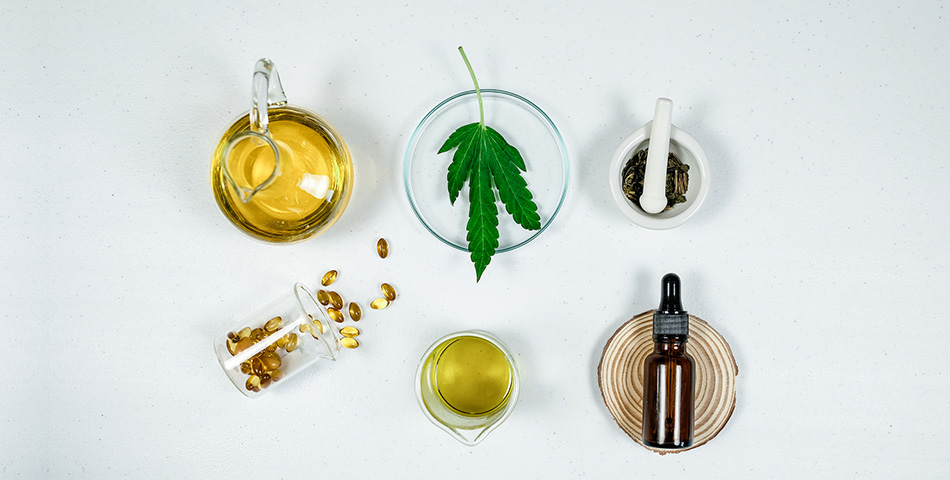Yoga, meet CBD! We think you’ll find this hemp-derived compound very helpful . . .
But wait—there’s a twist.
While CBD and yoga may seem like a modern-day match, the pairing actually goes way back. There’s much to be learned from how the ancients approached the practice of yoga . . . and how they amplified its benefits through strategic use of plant compounds like CBD.
CBD and the Transcendental Slate
Of course, traditional cultures didn’t know anything about CBD or other yet-to-be-discovered plant compounds. They didn’t need to!
Instead, these cultures were well-versed on the practical effects of different plants, hemp included. In Northern India hemp has been used for centuries, most commonly as charas (a rich handmade resin) or bhang(a sweet drink infused with this resin). To this day, the Indian language is rich in cannabis-related terms.
Evidence of cannabis use first appears in the Vedas—Hinduism’s most sacred texts—courtesy of the Hindu God Shiva. Speaking to NPR, a modern-day holy man confirms: Shiva has always loved cannabis; both for its relaxing qualities, and for its effects on meditation. The Vedas are clear that cannabis is a source of joy and liberation, given to humankind out of love and compassion to help them deal with the stressors of life (Abel, 1980).
Around the same time (2,000 BC) and in roughly the same place (N. India), the practice of yoga was being developed. The oldest of all the Vedas, the Rig Veda, is chock full of references to yogic practices. It’s in this text that yoga is first described as a discipline, a ‘yoking’ of oneself to higher ideals and higher flexibility levels. As within, so without.
And yoga may go back along the historical timeline even farther, according to sources like Yoga International: “the dating of astronomical events mentioned in the Veda may even push some hymns back as far as 4500 B.C.” Seeing as they’re mentioned in the same sacred books, the contextual intertwining of yoga and cannabis appears quite ancient.
When one stops to think about the many overlaps between the use of hemp and the practice of yoga, maybe their shared source of origin isn’t so coincidental after all.
For example, both acts tend to generate inner peace, communication, and clarity. Both can promote an internal transcendence over external sources of stress. And both are correlated with better health of every type: mental, physical, emotional
Could it be that ancient yogis learned through experience that cannabis perfectly complemented their craft? According to the 2,000-year-old Yoga Sutra, authored by yogic sage Patanjali, one can indeed use herbal remedies alongside yoga to achieve enlightenment.
Given that it may help clear the mind of inflammation [1], oxidation [2], negative emotion [3], and addiction [4], cannabidiol could plausibly be considered a transcendent compound. And this quality stands to benefit modern-day yoga practitioners just as much as it once benefited the sages of old.
In the past couple of years, a trend is emerging, one that seems to reflect these truths. CBD-fueled yoga is coming full circle! Let’s take a closer look . . .
CBD and Modern Meditation

While many people now realize that CBD can enhance general health, it may also enhance meditation.
By meditation, however, we don’t necessarily mean spirituality or prayer. In the information-overloaded age we live in, perhaps even a brief exodus from the pull of social media or the daily news can be considered meditative.
Let’s face it. Today’s culture is dependent, maybe even addicted, to technology.
That’s not all, though: stressors stemming from politics, the state of the economy, ongoing pandemics and more have gotten pretty good at, well, stressing us out. Making matters worse, the daily news seems to reflect our already troubled mindset with a glass-half-empty approach.
And, going back to technology again, with our culture’s widespread adoption of the smartphone comes the capability to be plugged into the news . . . constantly. Subjected to its negativity again and again and again.
Might CBD be part of the antidote?
There’s every reason to think so: a recent study involving drug-addicted rodents, of all things, gives us some clues. The study involved rats with cocaine or alcohol addictions being separated from their drugs of choice and getting dosed with transdermal CBD instead.
Normally, addicts of both the human and rodent variety exhibit “drug-seeking” behaviors, wacky hormone profiles, and high anxiety whenever addictive substances are withheld from them . . . but not these rats. They escaped the clutches of addiction remarkably well; in fact, 7 days of CBD “treatment” was enough to provide months of improvement.
Scientists have found that CBD promotes neuroplasticity via its ability to reduce harmful reward pathways in the brain. This mechanism clearly and powerfully benefited rats with alcoholism. “CBD may be highly effective and readily amenable for development as therapeutics,” the study’s authors concluded. Is it such a stretch to theorize that humans addicted to technology, sugar, or stress might benefit from CBD’s anti-addictive nature, too?
Yoga enthusiasts have already reported feeling more “focused and intuitive” thanks to CBD, and this pathway could help explain it.
To put it another way, both scientific and experiential evidence suggests that CBD could reduce the type of distractions that detract from your inner awareness and peace.
Meditation is all about emptying oneself of everything but one’s inner essence, after all . . . about getting back in touch with oneself. And CBD can most likely help. It seems to improve inner-state synchronization at the synaptic level. Larger doses of CBD can even be used to promote deep relaxation and sleep.
CBD for Functional Movement
Keep in mind that many of the principles discussed so far point back to CBD’s activation of the human endocannabinoid system (ECS), a system known by researchers as a “literal bridge between body and mind.” While cannabidiol impacts many other physiological systems, too, the ECS can be thought of as a biochemical spring from which CBD-related goodness flows. It operates ‘upstream’ of more commonly known pathways like the central nervous system or serotonergic system, which helps explain why CBD seems to combat so many different types of health challenges.
In recent years, the verdict has become increasingly clear: with consistent CBD use comes improved endocannabinoid health.
Improved ECS health, in turn, benefits the physical elements of yoga just as it benefits the more mental ones!
In general, people with sufficient endocannabinoid levels experience lower levels of pain, less inflammation, and fewer psychosomatic challenges than those with endocannabinoid deficiencies. Not surprisingly, a comprehensive 2008 review study, composed by the same neurologist who introduced the concept of endocannabinoid sufficiency in the first place, found that CBD could play a vital role in pain management.
In short, people with better endocannabinoid tone may have an easier time getting and staying active than others.
Indeed, it’s almost as if our endocannabinoid systems want us to exercise. The systems’ endocannabinoid components respond favorably to our workouts, rewarding us with increased production of the endocannabinoid Anandamide, whose name means “bliss” in Sanskrit. These same endocannabinoids give us the hunger we need to restore energy lost to exercise and the deep sleep needed to recover from it.
But CBD and exercise aren’t the only things that raise endocannabinoid levels and make us feel good. An uncanny number of wellness practices do, too. According to a 2007 study, these practices include “bodywork, diet and lifestyle modifications, and pharmaceutical approaches”.
The same study found that stretching caused the body’s endocannabinoid receptors to become more engaged. (Check out this article for more info on that topic.) Putting two and two together, it seems that stretch-based activities like yoga might make one’s body more receptive to both endocannabinoids like anandamide . . . and plant cannabinoids like CBD.
A more recent 2014 study further confirmed that yoga might strengthen the endocannabinoid system. Add CBD into this adaptogenic mix, and one might be able to experience yoga’s benefits even more fully:
“Stress management may reverse the effects of chronic stress on eCB signaling. . . . Clinical anecdotes suggest that stress-reduction techniques, such as meditation, yoga, and deep breathing exercises impart mild cannabimimetic effects.”
As time passes and more studies come out, look for yoga’s impact on ECS health to be fully confirmed. As with many other exciting topics within the CBD world, more research is needed.
Joint health might be improved thanks to CBD’s activation of the endocannabinoid system, too. Some studies show that CBD reduces pain in “collagen-induced” arthritis, while others have demonstrated the compound’s ability to rebuild collagen networks from the inside out. This same ability could help those with bone fractures experience faster healing.
The takeaway is clear: if joint stiffness has kept you away from yoga, consider CBD!
CBD and Flow

A yoga teacher who spoke to the Buddhist publication Tricycle was actually concerned about CBD working too well at reducing anxiety: “My concern is about the potential reliance on the CBD doing the job for you rather than actually doing the meditative work.”
At Green Maiden, we see things a little differently. Perhaps this yogi was wrong . . . but for the right reasons?
While indeed effective, CBD isn’t to be used as a crutch or bandaid solution—nor is its holistic mode of action conducive to such an approach. Instead, CBD should be used to strengthen the willpower and internal drive of its user.
If you’re ready to give CBD-fueled yoga a try, consider taking a normal dose of the plant compound an hour or two prior to your next session. Feeling extra adventurous? Take your CBD alongside a traditional nootropic like ashwagandha.
As we said, more concrete evidence is needed to fully verify cannabidiol’s effect on the practice of yoga. But that shouldn’t stop anyone from confirming that CBD does or doesn’t work for them! Besides, the anecdotal evidence is on your side.
Even Doctors like osteopath Dustin Sulak are praising the benefits of yoga + cannabis therapy; with time, many of Sulak’s patients have become “able to achieve a cannabis state of consciousness with yoga or meditation alone.”
In other words, they’re using yoga to optimize internal cannabinoid levels, having “found the switches to flip in their inner pharmacy to give them the desired effect without cannabis.”
That doesn’t sound like a bandaid solution to us. It actually sounds like a pretty empowering way to make use of the mind-body connection!
And this improved connectivity is just what thousands of yoga-loving CBD users—including our customers—are experiencing. Are you ready to join them? You’ll probably find that CBD and this wellness essential are the perfect match.
To your health,
Green Maiden




